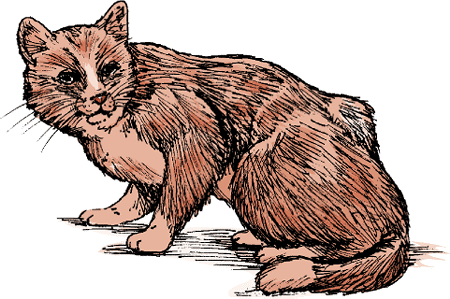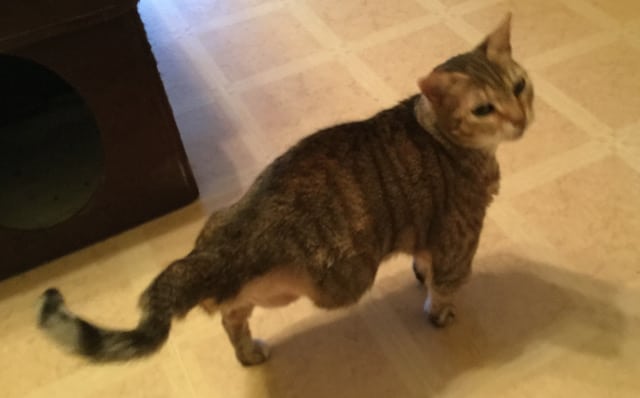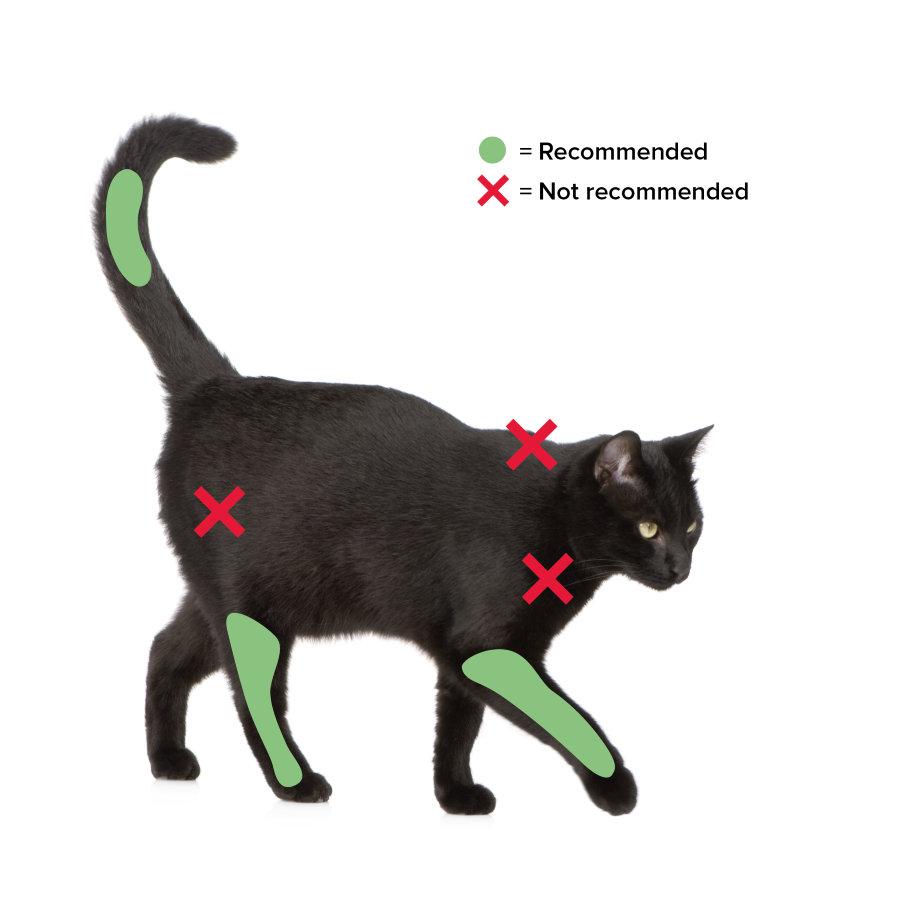fibrosarcoma in cats leg
Our 14 yo spayed indoor only cat Yum Yum was diagnosed with a fibrosarcoma on her right front leg a few weeks ago. Optimum treatment usually involves a combination of surgery with radiation therapy andor chemotherapy although the prognosis is variable depending on how aggressive malignant the tumour is.

69 Feline Injection Site Sarcomas Dr Pam S Vet Blog
Sarcomas affecting various body tissues have always been seen in cats but since the early 1990s the occurrence of sarcomas at sites commonly used for vaccination such as the shoulder lumbar region lower back flank side of body and upper hind leg led researchers to see if there was a direct association with vaccination.

. Fibrosarcomas are common in dogs and are a type of soft tissue sarcoma see. When fibrosarcoma develops as the result of vaccinations it is called vaccinosarcoma or vaccine-induced sarcoma. In my opinion your cats leg should have been amputated when the first tumor appeared.
Fibrosarcomas are common in older cats. In general any cancer is the result of cells dividing and growing uncontrollably. There are three causes of fibrosarcoma.
Fibrosarcoma first appears on your kitty as a firm mass. An injection-site sarcoma is a tumor of the connective tissues in the cat. The most common cell type affected is the fibroblast giving the tumor the name fibrosarcoma.
Prognostic factors and proposed grading system for cutaneous and subcutaneous soft tissue sarcomas in cats based on a retrospective study J Feline Med Surg. Many thanks Geri. Lethargy or lack of energy Weight loss and loss of appetite.
The cause has not been established although cancers more common in older cats. Connective muscle and nervous tissues are present throughout the entire body. This may be firm poorly circumscribed irregular and measure between 1-15cm.
In-depth Information on Bone Fibrosarcoma in Cats. They are most commonly associated with the rabies vaccine and the vaccine for feline leukemia virus. This is usually a single irregularly shaped mass found on the trunk legs and ears.
The tumor types behave similarly and are therefore treated the same way. Eventually as the cancer progresses cats with fibrosarcomas will develop these symptoms. Fibrosarcoma is very aggressive very fast-growing and deadly.
It may achieve substantial size before it is first noticed because it begins in or under the skin. The most common sign in a cat with a fibrosarcoma is a progressively enlarging firm swelling under the skin but this can affect almost any site. Fibrosarcomas have been recognized for a very long time as difficult deeply rooted tumors of cats.
Cats with oral fibrosarcomas may have difficulty eating and swallowing bad breath and drool. Unfortunately the full post-op biopsy has now come back as high grade. After testing CT scans and consult with oncology specialist we decided on a tumor removal as the initial sample biopsy showed low grade cancer cells.
The most common types of ISS in cats are fibrosarcomas and the most common injections associated with the development of ISSs are vaccinations. Signs of Fibrosarcomas in Cats Lump under the skin at the site of a vaccination Lethargy Decreased appetite. Treatment for FSA is usually surgical at least initially.
Feline fibrosarcoma is a type of highly malignant tumor that is known to develop where needles have injected vaccinations. Lumps may or may not. Other types of injections are also associated with tumor development including.
Get NHVs most useful pet cancer supplements in one holistic pack. In domesticated cats about 02 percent of vaccinations give rise to a fibrosarcoma tumor and once the condition has been contracted there is little any veterinarian can do to treat the problem. Call 530-752-1393 to schedule an appointment with the Oncology Service.
Other tumor types have been described osteosarcoma chondrosarcoma malignant fibrous histiocytoma. Vaccine associated fibrosarcomas are tumors that arise at sites where cats have been vaccinated. Geri- The current estimate is that about 1 in 3000 cats will develop fibrosarcoma and that the fibrosarcoma is likely to occur at a vaccination site.
Fibrosarcoma originate in the cells of fibrous tissues called fibroblasts then spread aggressively into other bones such as the femur tibia and mandible. Symptoms can vary depending on the location of the tumour but may include. Ad Help your pet cope with symptoms like nausea loss of appetite and energy.
Sarcomas are tumors of connective tissue and ISSs are a specific type of sarcoma arising at the site of a previous injection. Epub 2020 Jul 27. While vets still recommend that cat owners have their pets vaccinated vets will give one vaccine such as the rabies shot in one leg then give the feline leukemia FeLV vaccine in the opposite leg.
I cannot review the product you mention because I am not familiar with it. Malignant fibrous histiocytomas are most frequently found in the skin and soft tissues of aged cats. Therefore these tumors can develop over the chest back side legs and facial tissues of your pet.
Soft tissue sarcomas make up about 15 of cancers of the skin affecting dogs and about 7 of those affecting cats. However I strongly believe there is no cure for your cat other than amputation. They are most common on the lower legs or lower neck but may also occur at vaccination sites.
Authors Melanie J. This probably occurs because of reaction to the adjuvents in the vaccine -- irritating compounds included to increase its effectiveness. That is how horrible fibrosarcoma is in cats.
The use of vaccines is known to cause fibrosarcoma vaccine induced sarcoma. Localised soft tissue swelling. They seldom spread to other locations in the body but tend to invade surrounding tissues and return after surgical removal.
In medium- to-longhaired cats the lesion may progress even further until it is large enough to be noticed when petting. What has only recently been recognized is the potential for vaccination to lead to the formation of these tumors. Tumour to affect cats.
Causes of Canine Fibrosarcoma The exact causes of the tumor of fibroblast are not known. If fibrosarcoma occurs in an area of the body that can be completely removed with surgery the prognosis can be good for 1 to 2 years or more as it is a type of cancer that rarely spreads. Fibrosarcoma is an uncommon type of cancer to affect the bone.
The significant causes of cancer in dogs and cats are hereditary environmental trauma infectious diseases foreign bodies orthopedic implants and radiations.

Image Fibrosarcoma Cat Merck Veterinary Manual

Tumors Of The Skin In Cats Cat Owners Merck Veterinary Manual

Connective Tissue Tumors In Animals Integumentary System Msd Veterinary Manual

Tripawd Tuesday Lawri Beats The Feline Fibrosarcoma Odds

Update On Feline Injection Site Sarcomas

Post Vaccination Sarcoma In Cats Vca Animal Hospitals
Feline Fibrosarcoma In The Cheek A Surgical Story Dr Phil Zeltzman S Blog
